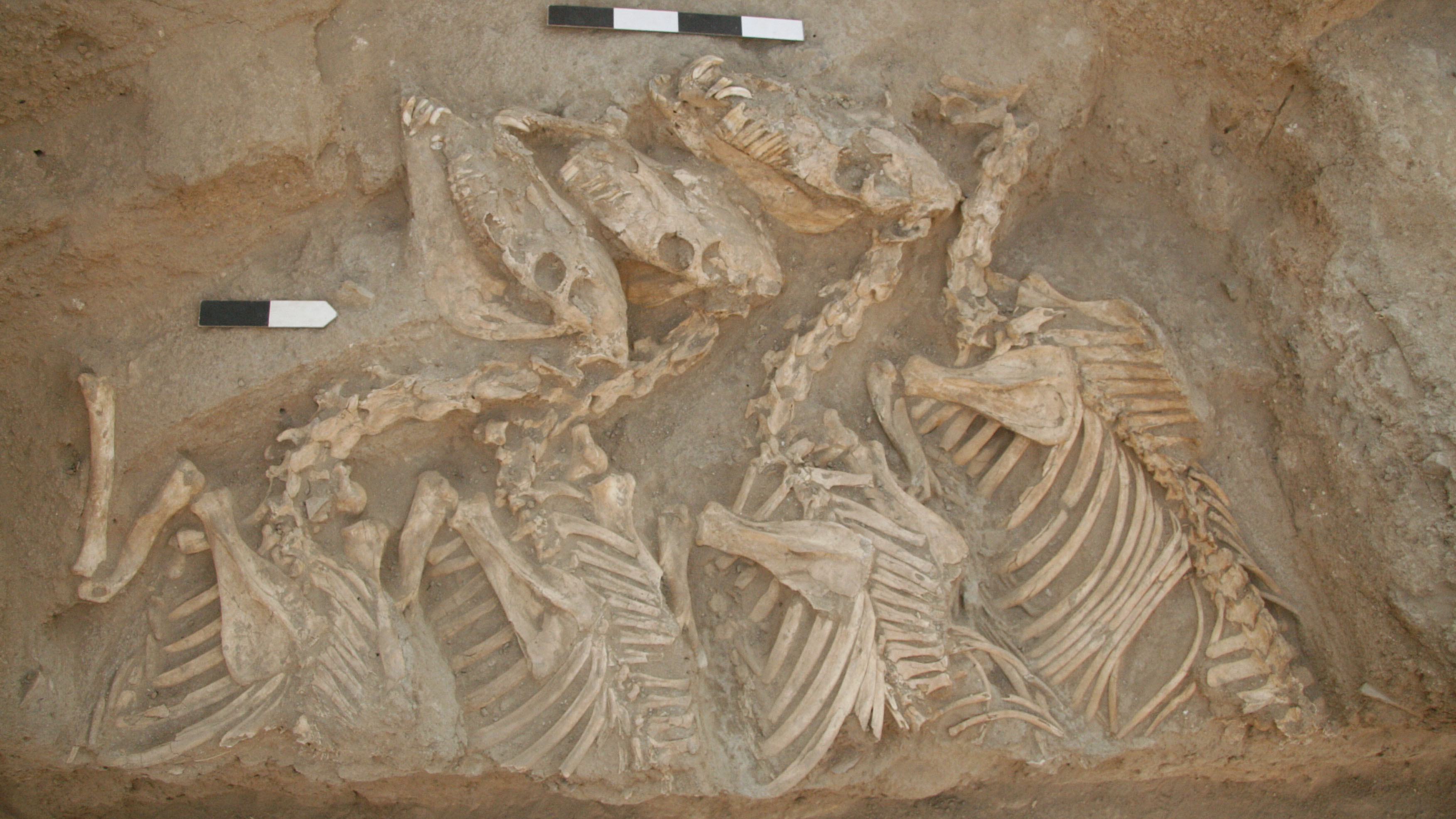Is The Pig A Hybrid Animal Egyptian
1st bioengineered hybrid animals discovered — in aboriginal Mesopotamia

Mesopotamians were using hybrids of domesticated donkeys and wild asses to pull their war wagons 4,500 years ago — at least 500 years before horses were bred for the purpose, a new report reveals.
The analysis of ancient Dna from animal bones unearthed in northern Syria resolves a long-standing question of but what type of animals were the "kungas" described in ancient sources equally pulling war wagons.
"From the skeletons, we knew they were equids [equus caballus-like animals], but they did not fit the measurements of donkeys and they did not fit the measurements of Syrian wild asses," said report co-author Eva-Maria Geigl, a genomicist at the Institut Jacques Monod in Paris. "So they were somehow different, simply it was not articulate what the difference was."
The new study shows, nonetheless, that kungas were stiff, fast and still sterile hybrids of a female domestic donkey and a male Syrian wild donkey, or hemione — an equid species native to the region.
Related: Horned figures from cult of a Mesopotamian moon god discovered in biblical-era fort
Ancient records mentioned kungas equally highly prized and very expensive beasts, which could exist explained by the rather hard process of breeding them, Geigl said.
Because each kunga was sterile, like many hybrid animals such equally mules, they had to be produced by mating a female domesticated donkey with a male wild donkey, which had to exist captured, she said.
That was an peculiarly hard chore because wild asses could run faster than donkeys and even kungas, and were incommunicable to tame, she said.
"They really bio-engineered these hybrids," Geigl told Live Science. "There were the earliest hybrids ever, as far every bit nosotros know, and they had to practise that each fourth dimension for each kunga that was produced — so this explains why they were then valuable."
State of war donkeys
Kungas are mentioned in several ancient texts in cuneiform on clay tablets from Mesopotamia, and they are portrayed drawing four-wheeled war wagons on the famous "Standard of Ur," a Sumerian mosaic from about 4,500 years ago that's now on display at the British Museum in London.
Archaeologists had suspected that they were some sort of hybrid donkey, but they didn't know the equid it was hybridized with, Geigl said.
Some experts thought Syrian wild asses were much as well small-scale — smaller than donkeys — to exist bred to produce kungas, she said.
Related: Mustangs: Facts nearly America'south 'wild' horses

The species is now extinct, and the last Syrian wild ass — not much more than a meter (3 anxiety) alpine — died in 1927 at the world'southward oldest zoo, the Tiergarten Schönbrunn (opens in new tab) in Vienna in Austria; its remains are now preserved in that urban center'southward natural history museum.
In the new report, the researchers compared the genome from the bones of the terminal Syrian wild ass from Vienna with the genome from the eleven,000-yr-old bones of a wild ass unearthed at the archaeological site of Göbekli Tepe, in what is at present southeastern Turkey.
That comparison showed both animals were the same species, just the ancient wild ass was much larger, Geigl said. That suggested that the Syrian wild ass species had get much smaller in recent times than it had been in artifact, probably due to environmental pressures such equally hunting, she said.
Ancient Mesopotamia
Historians think that the Sumerians were the first to breed kungas from before 2500 B.C. — at to the lowest degree 500 years before the first domesticated horses were introduced from the steppe northward of the Caucasus Mountains, co-ordinate to a 2020 study in the periodical Scientific discipline Advances (opens in new tab) by many of the same researchers.
Ancient records show the successor states of the Sumerians — such as the Assyrians — continued to brood and sell kungas for centuries — and a carved stone panel from the Assyrian capital Nineveh, now in the British Museum, shows ii men leading a wild ass they had captured.
The kunga bones for the latest written report came from a princely burial circuitous at Tell Umm el-Marra (opens in new tab) in Northern Syria, which has been dated to around the early on Bronze Age between 3000 B.C. and 2000 B.C.; the site is thought to be the ruins of the ancient city of Tuba mentioned in Egyptian inscriptions.
Written report co-writer Jill Weber, an archaeologist at theUniversity of Pennsylvania, excavated the basic near ten years ago. Weber had proposed that the animals from Tell Umm el-Marra were kungas considering their teeth had marks from bit harnesses and patterns of article of clothing that showed they had been purposefully fed, rather than left to graze like regular donkeys, she said.
Kungas could run faster than horses, and so the practice of using them to pull war wagons probably continued afterward the introduction of domesticated horses into Mesopotamia, she said.
But somewhen the last kungas died and no more were bred from donkeys and wild asses, probably because domesticated horses were easier to breed, Geigl said.
The new study was published Friday (Jan. 14) in the journal Science Advances (opens in new tab).
Originally published on Alive Scientific discipline.
Source: https://www.livescience.com/hybrid-kungas-discovered-mesopotamia
Posted by: schoonoverwidep2001.blogspot.com

0 Response to "Is The Pig A Hybrid Animal Egyptian"
Post a Comment